People with the surname
- Luis Cruzado (1941–2013), Peruvian footballer
- Rinaldo Cruzado (born 1984), Peruvian footballer
The word cruzado (Portuguese for "crusader") may mean:
The centavo is a fractional monetary unit that represents one hundredth of a basic monetary unit in many countries around the world. The term comes from Latin centum,, with the added suffix -avo ('portion').

Pacheco is a Portuguese and Spanish name which may refer to:
Brazilian cruzeiro refers to any of four distinct Brazilian currencies:

The cruzado was the currency of Brazil from 1986 to 1989. It replaced the second cruzeiro in 1986, at a rate of 1 cruzado = 1000 cruzeiros (novos) and was replaced in 1989 by the cruzado novo at a rate of 1000 cruzados = 1 cruzado novo.
Pedro is a masculine given name. Pedro is the Spanish, Portuguese, and Galician name for Peter. Its French equivalent is Pierre while its English and Germanic form is Peter.

The Brazilian currency has been renamed and redefined several times through its history. Since 1994, the official one is the Brazilian real (plural reais, with symbol R$ and ISO code BRL.

The real was the unit of currency of Portugal and the Portuguese Empire from around 1430 until 1911. It replaced the dinheiro at the rate of 1 real = 840 dinheiros and was itself replaced by the escudo at a rate of 1 escudo = 1000 réis. The escudo was further replaced by the euro at a rate of 1 euro = 200.482 escudos in 2002.
Sol or SOL may refer to:
Jaime is a common Spanish and Portuguese masculine given name for Jacob, James, Jamie, or Jacques. In Occitania Jacobus became Jacome and later Jacme. In east Spain, Jacme became Jaime, in Aragon it became Chaime, and in Catalonia it became Jaume. In western Spain Jacobus became Iago; in Portugal it became Tiago. The name Saint James developed in Spanish to Santiago, in Portuguese to São Tiago. The names Diego (Spanish) and Diogo (Portuguese) are also Iberian versions of Jaime.
Manuel is a male given name originating in the Hebrew name Immanu'el (עִמָּנוּאֵל, which means "God with us." It was possibly brought from the Byzantine Empire to Spain and Portugal, where it has been used since at least the 13th century. Manuel is popular in Spanish, Portuguese, German, French, Romanian, Greek, Polish and Dutch where Manny or Manu is used as a nickname.
Moreno may refer to:
Indio may refer to:

The Cruzado Novo was the short-lived currency of Brazil between 15 January 1989 and 15 March 1990. It replaced the cruzado in the rate of 1000 cruzados = 1 cruzado novo. It had the symbol and the ISO 4217 code BRN. In 1990, the cruzado novo was renamed the (third) cruzeiro. This currency was subdivided in 100 centavos.

The Brazilian real is the official currency of Brazil. It is subdivided into 100 centavos. The Central Bank of Brazil is the central bank and the issuing authority. The real replaced the cruzeiro real in 1994.

Hyperinflation in Brazil occurred between the first three months of 1990. The monthly inflation rates between January and March 1990 were 71.9%, 71.7% and 81.3% respectively. As accepted by the International Monetary Fund (IMF), hyperinflation is defined as a period of time in which the average price level of goods and services rise by more than 50% a month.

In 1986 because of inflation banknotes of the cruzado were issued by Central Bank of Brazil in denominations of 10, 50, 100, 500, 1000, 5000 and 10 000 cruzados. This bank had the sole authority to issue cruzado notes and Casa da Moeda do Brasil was the sole printer of these banknotes. Cruzado notes on the front/obverse featured prominent people while on the back/reverse depicted buildings and/or activities of those people mentioned before. Between 1989 and 1990 cruzado currency had also been replaced, this time by cruzado novo at a rate of 1 cruzado to 1000 cruzados novos.

The cruzeiro was the currency of Brazil between 1990 and 1993. It was the third iteration of a Brazilian currency named "cruzeiro", and replaced the cruzado novo at par. It was used until 1993, when it was replaced by the cruzeiro real at a rate of 1 cruzeiro real = 1000 cruzeiros.

The cruzeiro, initially denominated cruzeiro novo between 1967 and 1970 in the transition from the previous standard banknotes issued by American Bank Note Company and Thomas de la Rue to the new banknotes issued mainly by Casa da Moeda do Brasil, was the currency of Brazil between 1967 and 1986. It was introduced due to inflation and financial instability in the country, and had a conversion rate of 1 cruzeiro novo equal to 1000 "old" cruzeiros.
NCZ can refer to: